Transparent soap tutorial
Safety in the first place
- Prepare your workplace and keep it organize.
- Educate your family and special care with young children.
- Be sure you understand the process.
- Wear rubber gloves and safety glasses.
- Never leave the hot oil unattended.
- Never leave the soda and soda solution unassisted.
- Work with method.
- Do not get distracted at work.
- Clean up spills immediately.
Fairly simple formula with babassu palm and castor. Stearic acid is a saturated fatty acid (C18) of animal or vegetable origin. Here we used the vegetable, it is not easy to find. Glycerin can also be bidistilled of animal or vegetable origin (biodiesel), but it is very difficult to establish its true origin.
Equipment
The safety equipment, goggles and gloves are essential and should always be used in handling of raw materials and the process.
In this process is used a slow-cooker “crock pot” to perform the saponification reaction, which is a hot process “hot process”. This pan allows a more controlled, clean and safe. It could be used a system-bath instead. The characteristic heating the pan Narita NSC-35 that was used in this tutorial is seen below:
Heating caracteristic
As you can see, it’s a slow cooker heating whose maximum temperature is reached at 180 min and not exceeding 85°C in regulating high.
Mold preparation
Mold for 13 bars with 100g. The lining used was acetate sheet and is reusable, with pieces of waxed paper to protected the corners.
This lining is made from reusable acetate sheets but may be used plastic sheet for binding, sold by stationery store.. Are cut according to the inside dimensions of the mold and joined with tape.
The angles of paper are placed in the corners of the mold to prevent possible leakage of the soap mass.
Here is the mold lined and ready for use.
Preparing the ingredients
Weigh castor oil.
Blend all previously weighed ingredients in a plastic container 2 liter polypropylene.
Melt the oils and stearic acid in the microwave for 2:30 minutes on high, until completely dissolved.
Add lye over water with constant stirring. Never add water over soda to avoid a potential accident situation! Allow to cool to 40 ± 1 ° C.
Weigh ethyl alcohol (ethanol), away from open flames!
Add slowly while stirring the alcohol on lye solution. Do this away from open flames to prevent accidents!
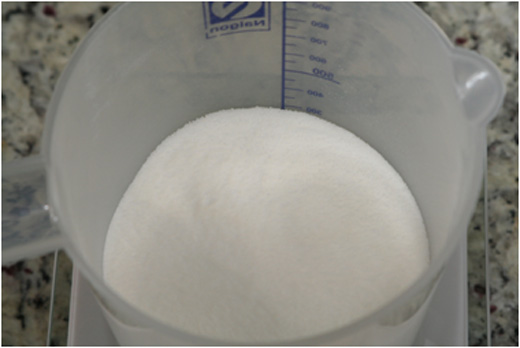 Weigh the sugar and dissolve in hot water and stir until completely dissolved.
Weigh the sugar and dissolve in hot water and stir until completely dissolved.
Prepare the hot water bath. Here you are using an electric heater (plate) but may be dispensable if you to work fast.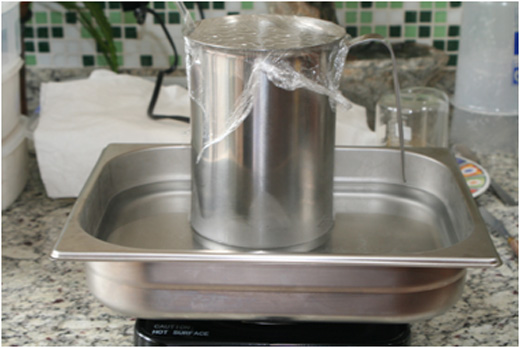
Heat the lye solution and alcohol, keeping at 42°C.
Process
Putting the mixture of oils in the slow cooker and maintaining the process temperature, 61°C.
Check the temperature of lye solution and alcohol 42°C.
Add slowly with manual stirring with a mixer, the lye solution and the alcohol over oils.
 The beginning of the saponification reaction is almost immediate.
The beginning of the saponification reaction is almost immediate.
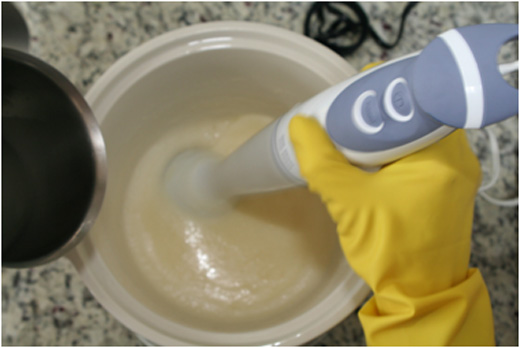 Milky appearance and viscosity increase, turning on the mixer and stir
Milky appearance and viscosity increase, turning on the mixer and stir
Continue adding, the mixer on.
Large increase in viscosity and forming lumps. Continue adding and stirring.
Start liquefaction with decrease in viscosity. Scrape the edges with a spatula to incorporate and homogenize.
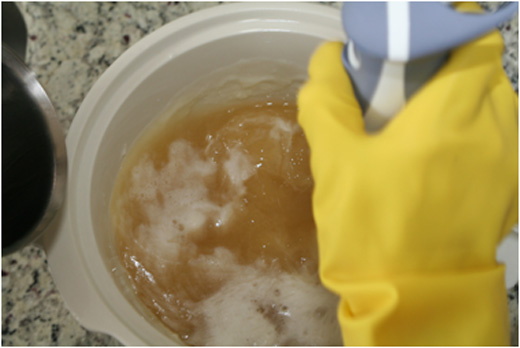 Complete liquefaction and initiation of transparency.
Complete liquefaction and initiation of transparency.
Finished the addition of lye solution and alcohol and foaming forming. Decrease stirring to avoid the formation of too much foam.
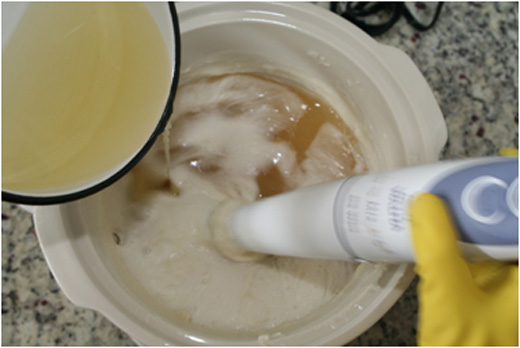 Add the sugar solution slowly with moderate agitation.
Add the sugar solution slowly with moderate agitation.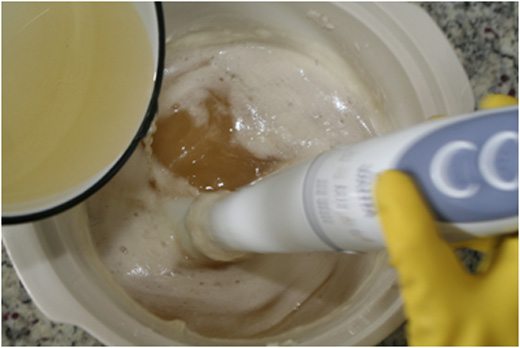
Enhances foam formation. Stir carefully.
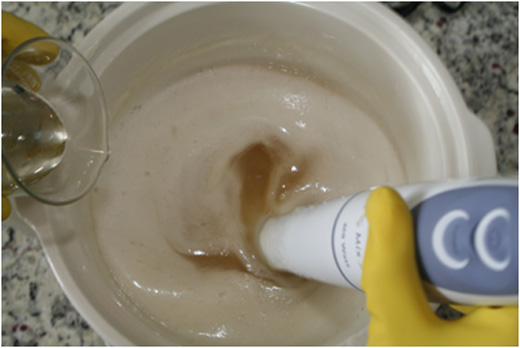 Add the glycerin with moderate agitation.
Add the glycerin with moderate agitation.
Finished the addition of glycerin. The temperature should be about 70°C.
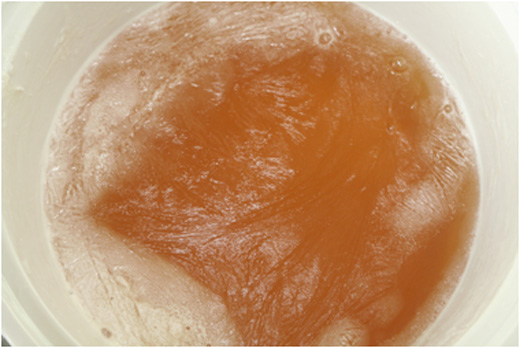 Remove with a spoon excess foam.
Remove with a spoon excess foam.
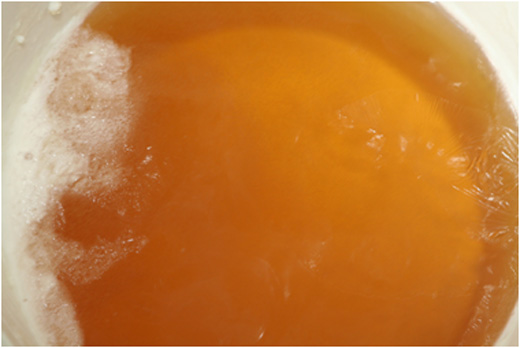 Saponification reaction complete.
Saponification reaction complete.
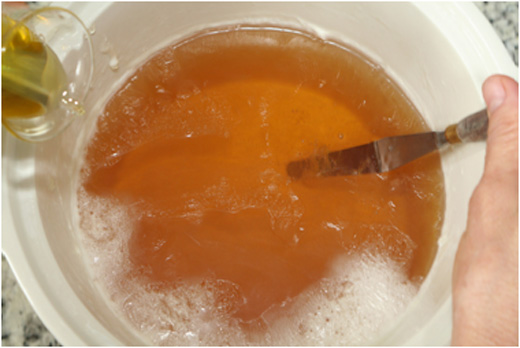 Allow to cool below 60°C and add essential oils.
Allow to cool below 60°C and add essential oils.
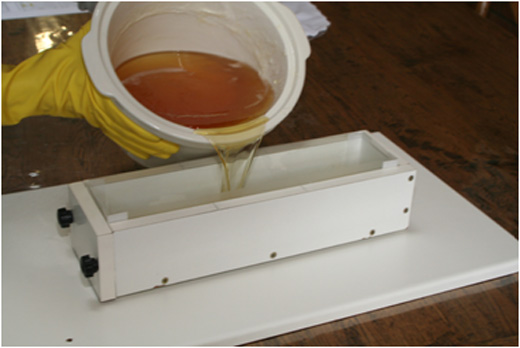 Still hot pour into the mold carefully.
Still hot pour into the mold carefully.
Hot the soap is verry liquid. Be carefully!
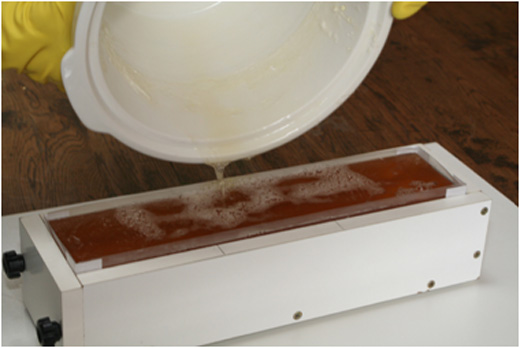 Eliminate superficial foam with a spatula or spoon.
Eliminate superficial foam with a spatula or spoon.
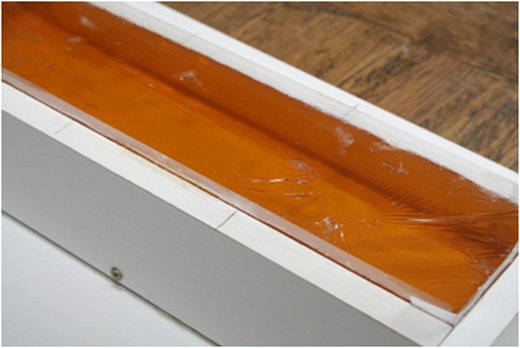 Wait 12 hours to cool and solidify.
Wait 12 hours to cool and solidify.
Remove the soap bar from the mold and is ready.
It is normal to have a pullback on the surface of the bar soap. Flush if necessary.
Cutting the bar
Cut the bars in the measure chosen. These were cut into individual cutter to weigh 100 g.
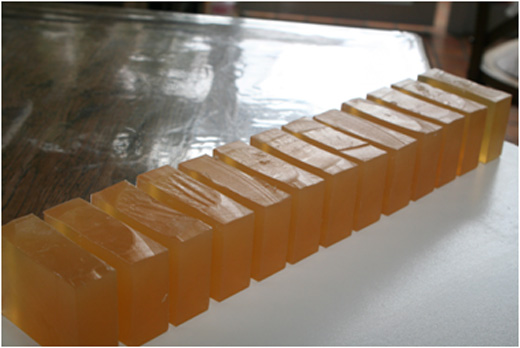 Here 13 bars ready for drying for two weeks.
Here 13 bars ready for drying for two weeks.
Quality control
After 24 hours from the start of drying, an aliquot is withdrawn from the sample bar counter for measuring the pH.
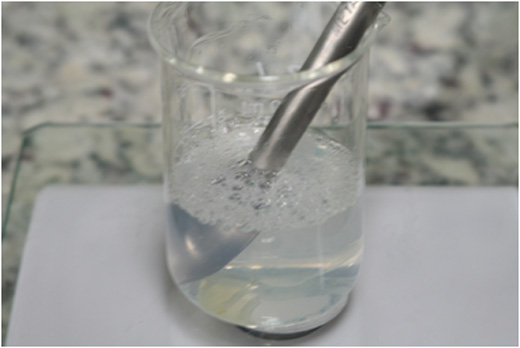 The aliquot is dissolved in water.
The aliquot is dissolved in water.
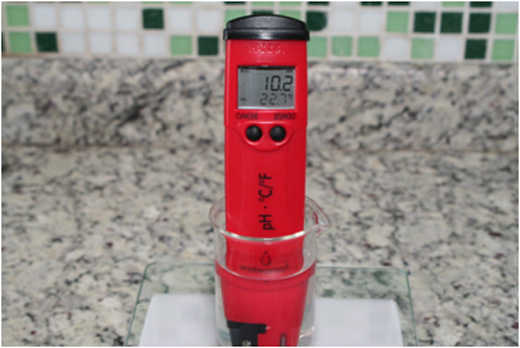 Using a portable digital pHmeter pH is measured. 10.2 is ok.
Using a portable digital pHmeter pH is measured. 10.2 is ok.
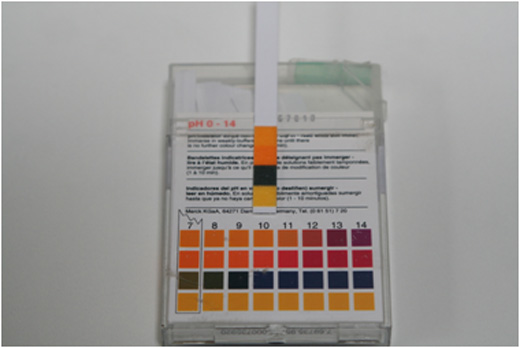 One can use strips of pH paper.
One can use strips of pH paper.
Thanks

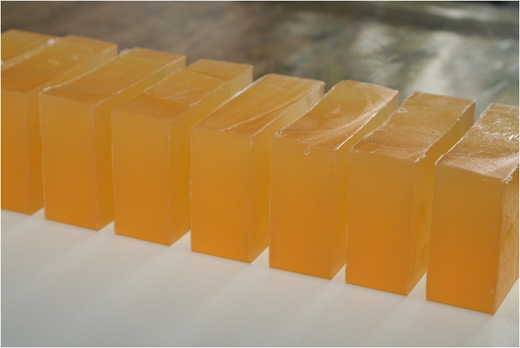


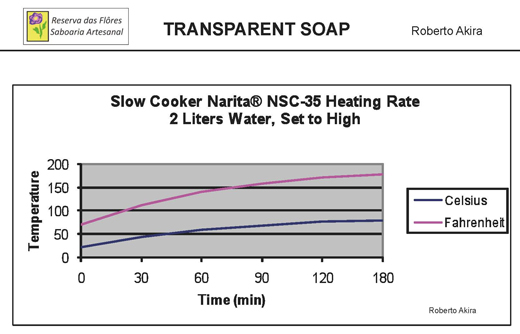
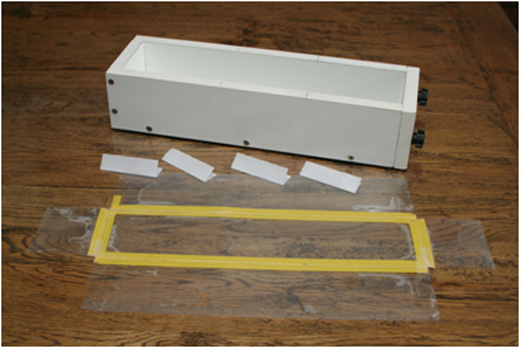
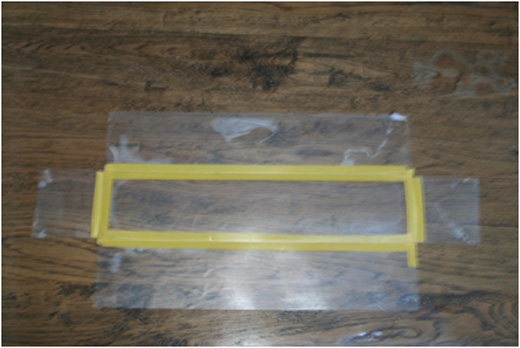
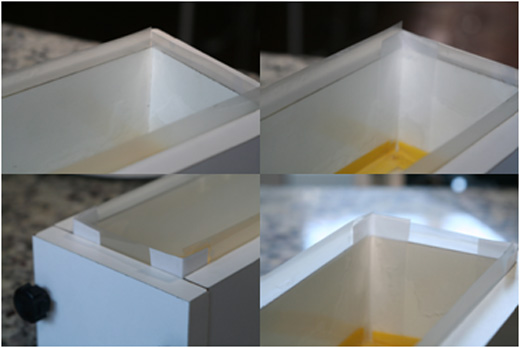





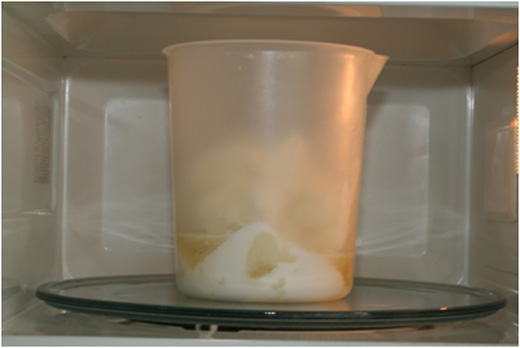

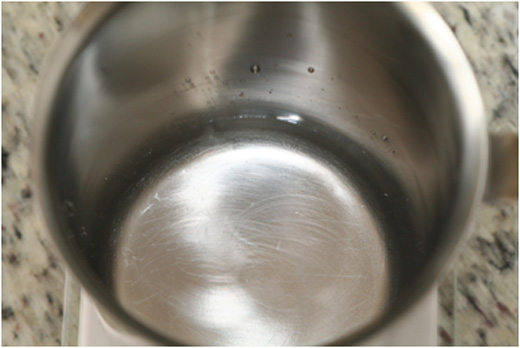

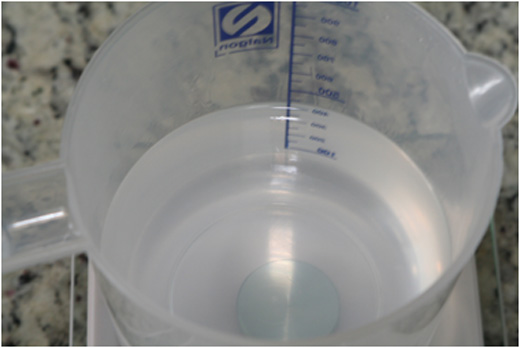

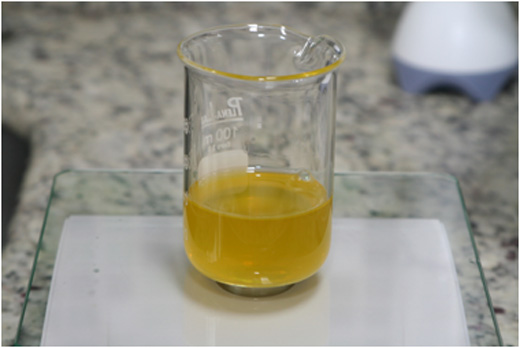
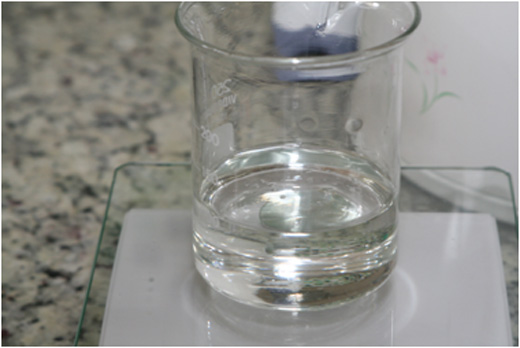
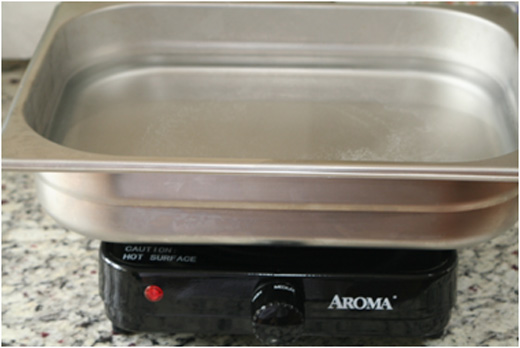

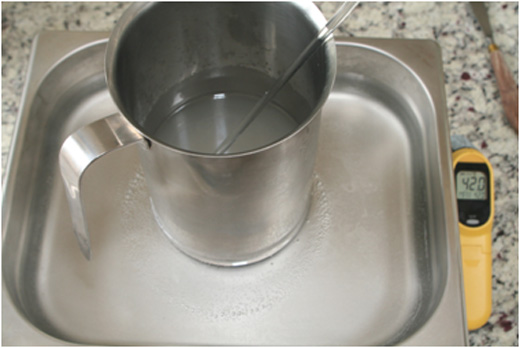
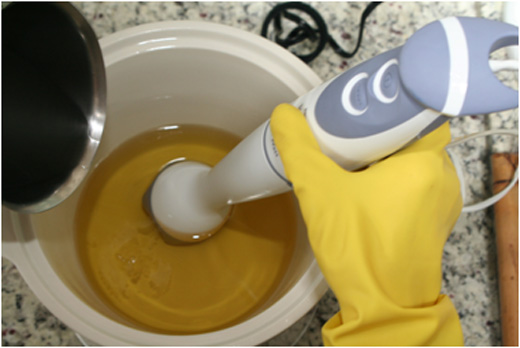
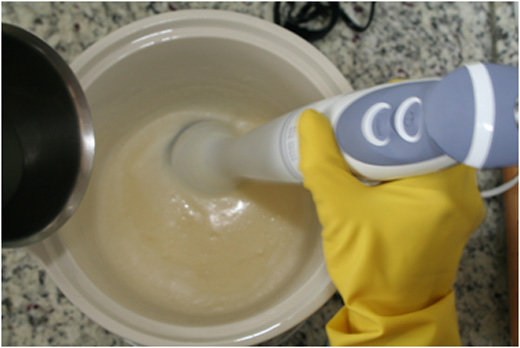
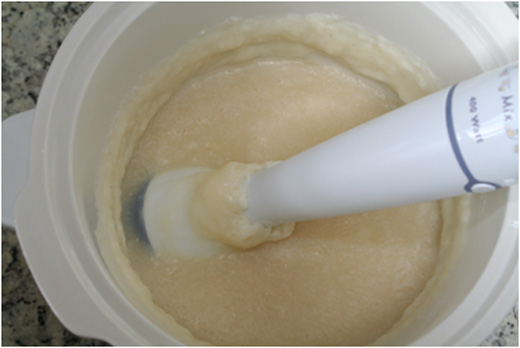

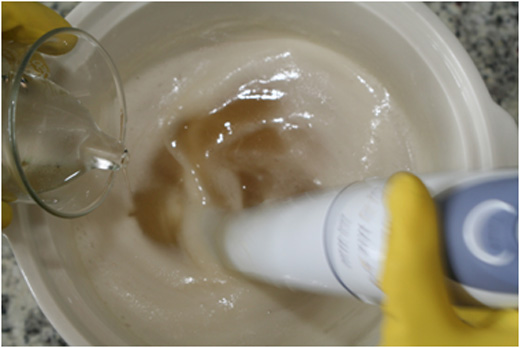
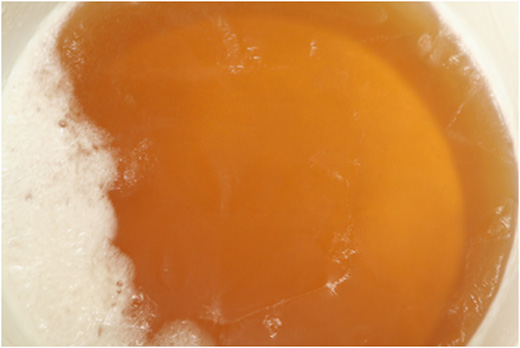
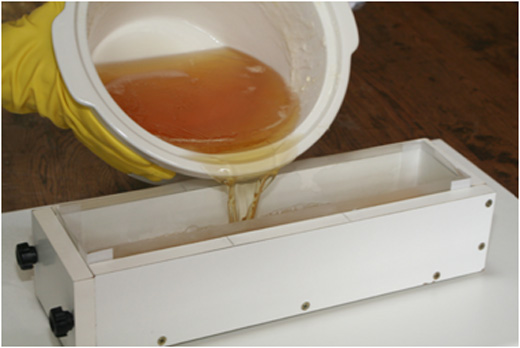
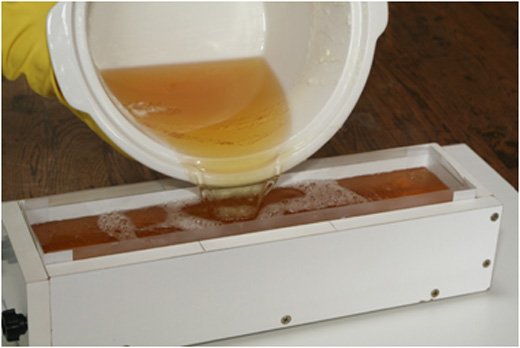
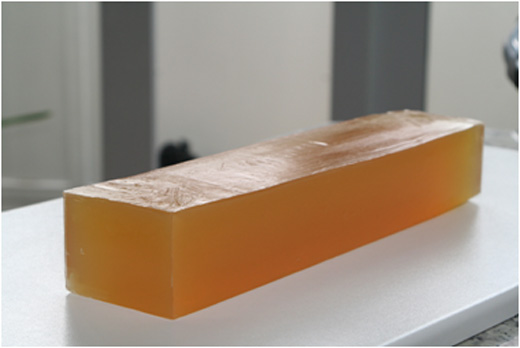
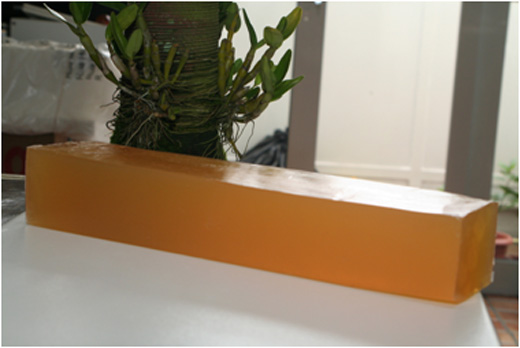
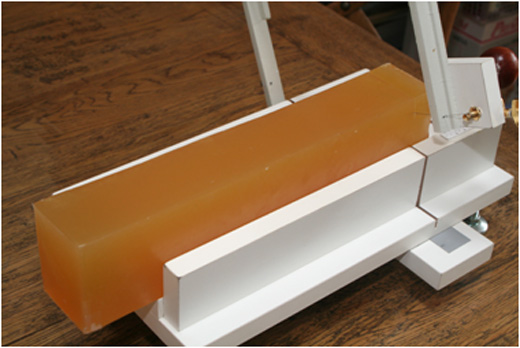
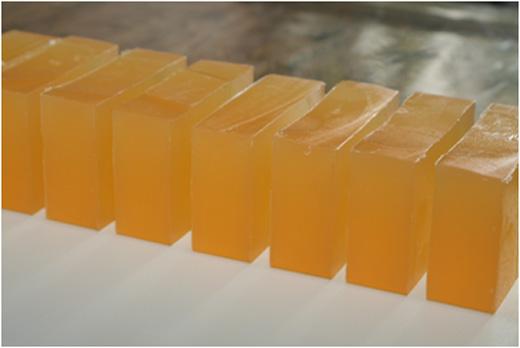





sir can you help me about white transparent soap making. i shall be thankful to you.
Best Regards,
M Faizan Sayan
Hi Sayan,
What’s mean white transparent soap? Opaque white?
Please give me more information
thanks for replying. actually i want to make water white color of transparent soap. for example just like glass. No yellowish shade. image of that transparent soap is https://encrypted-tbn3.gstatic.com/images?q=tbn:ANd9GcSzp0gpbhlqzF0rsLatNjhkrj4vzyt8pFq73-1GAi6F9CNm2JFA
data:image/jpeg;base64,/9j/4AAQSkZJRgABAQAAAQABAAD/2wCEAAkGBxQTEhIUEhQUFhUVGBgXGRgYGRQXGBQXFBQXFhcUFhUaHCggGBolGxUWITEhJSkrLi4uFx8zODMsNygtLisBCgoKDg0OGhAQGiwkHCQsLCwsLCwsLDcsLCwsLCwsLCwsLCwsLCwsLCwrLCwsLCwsLDc3Kzc3KysrLCwrLCsrK//AABEIAHAAlQMBIgACEQEDEQH/xAAcAAACAgMBAQAAAAAAAAAAAAADBAIFAQYHAAj/xAA5EAABAwIDBQYDBgYDAAAAAAABAAIDBBESITEFBkFRcSJhgZGhsRMyQlJicsHR8BQjQ4Lh8QdTY//EABkBAAMBAQEAAAAAAAAAAAAAAAECAwQABf/EACIRAAICAwABBAMAAAAAAAAAAAABAhEDITESEzJBURQiYf/aAAwDAQACEQMRAD8AhtnFUTumYGtZ8oBbe4HG2VkL+Bd9lh6XH6q7p6RzzYC5VzDsuNgs7tu9AsnlObtcNFQgqZpzaQ/Yd/a9EYxw4zD1W6mmaRYtb5W8iqbadVBG8Rgu+KfoBxWHN3JdJTirOi8cnWypbUPH9R39zSjMr5P+xh6hWIYsOZzAUvWf0W9BCzNoS/8AmehRRtGTjGPAqJijOrW+QRaaFrTk0Dvsrx8ntom8cfsyzaDj/Sf4ZptkxP0PHgpMzRWN5Jg+kgJqAPmu3qCFrm+dY3+HxNc1xxACxBz4DJbaZCOfqk63ZkExDnxRl32rWdl94ZlcI8dM0DYWwmWDnNBcczcDir51E1o7IA6BXhoGMyb5HXwKVc/tEEWss84Su2aIyXwadtdx5ZLXpxe911KWJpGYCQm2XE7VoTRyVoVwOZujR6aaRnySPb+Fzh7FbrPu3EdLhJS7rD6XeaqssSbxlXFvJVtFhUy+Lr+pWEw/dyS+RC8qeovsX0/4dVa/D2WjC3n9rxRGj939StY2NvIJYBJHFI51heNlnAu5XOma9VulnAbKGMb9UUZOZ5SP5fdC5tR6Z4pyYev2y6W7KZ2Fo7Lp9QObYW/U7v0Cxs+iawDCLd5ze8nVz38SiQwAW7hYZWAHIDgEcBY8mby0uG7FhUdvpMhCe26wZMroePTmqYsXjtjSd6MfA705Txg8dEFkfEolEc3K7eibirGJBZTj4JeV3aAUg6yTZSKRORx7/dHpG28Uk6ozCsC4EC3Bc3QslY8+BlhbMpCo2e06aeo6d3coU+brklWkMXPw5H/KDkIsdGtVMJabH/aWLVslfRggg8fQ81rssZBIOoWearhdAXMUHNRcKg4pUzqAELK84ryawUc+3D2pgldHcgHK4NrrptPHlkub7lbtTCQSSNwt+9r4BdSjZkmztOWhMKaWzAChM6w6o4Ylq11j4e6nijciknSA4r56Ae6JTR3NyhsGg8+qeDeS3tkkYkdZZ2ezJx5n2S85ysrGNmFgHd7pHwN7AltyV4xozWWUXBcETMfbb1TUj7AoUQ7Y8VOqGgQYEEpXK1p5rixVMzJFbMUGhrLY1AN2u+YceY5qo2pFexHQ/ki/GvbmhSXIseP7CDhaEUitLUNwR7IbishYXLV5EIXkTqDxNCYaEGNHaEoSYSdY3teXonB4oU8d/I/mq4HUhMntFaYZ3ViNFXUqsW6LXJbJoXDLvaO9Py6hApGdsngB7osb7klB9ORIhDciysJQJAQuQSEDe34IjsyhQvzd4eqYaxc+gRA6oNQ+wKPZJVxs0orp0tI9SVozyzAuriMh4FyBbTv42WqUEgxHPW4tz6LYGutGCOAv6XTyjTM8XaOYVG9M8csjbtcGvcMwDkHEapiHfk6PiB6Ot6ELT6ypBe88S5x83EpY1Q4WVZYcb6hFlmvk6NHvhTnUPHgD+a8ucRTh17EZczbyXlP8fEU/Imd1YxEaFBgTMEbnZNBPQXXmUbbogCoteC4jiMv1VnLsuRrHPc3CGi+evcLJahpwBfiVXHFp2xXJSVIrY25nmPZONGRRX0WInB8wztzA5d6Be2Tv9LX3ZHmhyhZ/Jkedb4R+/FTijsFmMgRsbzJcfyRQEk2GHCJYEhVM709IElVGwKEBmKUmpvzv5aJ4uSlDEbdU4Y8kzYEDJVdtCQZDmbJyYWVTXXLm24JoLYuT2goI825Z3urPbUobCWcXjBrwOufRRoYcwTwVPLXfHlu35BcN787F3j7IzZPDCyMWwKYswugjt3AA+et1zDevYLKaYta4lru024GQvpfiuy3s3PguXf8AILg6piaXYRhNzwALtSuxveymeKUbNVpqHHe0jG2t8xte/JYR/jPgc5sb2uBtmBcHLhfqsq1GQ+s6LYUDPpxfiN/RW0bABkAB3IMZVJvpt51LAHR4cbnAAHPLiUsYL4Ey5lCLlN6RPe2o7McY1ccR6N/yfRUrRYZob9o/xD/i2IBa2wPAW/UlEdms8+noYV+qM3BzGR/PqoVYMxYCBe9ieLh3jmhOktdVFXXO+NFGwYnSPay2nzG2Lw18EIyoecEy/q5B8QgZBoA8giscl3R4ezIQ57XWdbVtu/ipfC5O155FM0Ti9B3lV1S/MAcUy5rgND+SrfiF0mmSEYhsso2iyO0hL4jYZKBeUGrGMVjQqYx4iQeicr9pRxtJe4ZZnu6lct3p38c4Ojpew05GT6nfh5dVWCIZJGy7x7xtY5tHCQ6V5wvIOUTbdrMfVbyT+xoAABoLce5aTuNQB/8ANI5tBzzz7R8SuiwRgBLN7ofCqVnqx/ZyXG98qnHVPI0bZvlmfddV2pLha53AAnyXGa0Of/NNrPc4jmc76J8aBnlqiNTA5hAdbQEW5HReQBIvKxlPsYVYBstc31ijmgN83tcLHS1yMXW4QaGoc55zLu1fTIA96qtsMLHhmIOJ7TjnlwANyb6XU3kdaEeFTfhLaGqBwA5BHlmtokaRoA5/vkiTZrMz1IC9dV2BSm4MuOullktaCNzz92+Q9MSYnpwUOjoGMGQFzqefXmujp2GStND9LN8V7n3zcS7zOiemkwjPPy9knC4CylNLxXW0coJkZNpxt1fg6nCiOrLmxfyNi7mLg68iquWFspIIFkNtKfiucTixG5JGlgAB0sAipgePZa1FY0avv4qjraxzr5m3AaKyqGiwt7Kvlyvey5NnOKRpG+9URFhP1ED1Wl7NojPK2MaHNx5NGpV3vzWYpsI0arTcGjDYjL9UjrDua0297q11GzNJeeSjbtj07I2Na3IAADuVqZRwOSHGywCiWE5qJoo1vfeuLKeS3Hsjq7JcqEllvv8AyfUACKO+pxHwFvcrQS/mrw0jJl9xAuXlkLyckf/Z
i’m waiting for your kind response.
if you would like make ultra clear soap you should use only stearic acid and avoid using any other kind of oil or fat
thanks Mr. Abdul Rahman
i have tried this one but in result the soap was too hard just like white stone no foaming and transparency. i’m waiting for your other kind reply.
Beautiful soap! Congratulations on your success. Thank for the tutorial. I don’t know if you are familiar w/the brand “Pears”. They make a transparent soap that I used for years and loved. I am interested in trying this recipe however, the thought of adding alcohol to the lye solution is daunting. I understand your hesitancy!! Thanks for sharing.
Kerry,
Thank you!
Thank you very much for sharing this. I have tried it and love the result. I did substitute the babasu oil with coconut oil because that what I had in hand…..
Ennie,
Ok the babasu is similar to coconut oil almost same fatty acid composition
Thank you very much for sharing, I have tried this but I used coconut oil to replace babasu oil and only add 5% glycerin. Love the result 😉
Thanks a lot for sharing valuable information.
Does Alcohol evaporate form the final soap bar or it is a part of the final product?
Thanks in advance
Naltham,
Part of alcohol will evaporate from soap during saponification but de main % will stay in final product.
Roberto, 1) Is there a cook time between the “Large increase in viscosity” step and the “start liquefaction” step? From the photos, it looks like the steps are one after the other, with no cook time between. 2) What is the total time it takes to make the soap? 3) Can I use the soap like melt and pour if I don’t want to scent the whole batch of soap at one time? 4) So this recipe has a 5% superfatting right? I know, too many questions!!! Sorry!!! I’ve made transparent soap, but want to try different recipes to see which result is better. Thanks so much!!!
Jill,
1) Yes, there is no time between, is almost immediately, less than one minute.
2) The total time is aprox. 30 minutes, depends of temperature (crock pot)
3) No, this soap not melt because has palm oil
4) The SF is 5%
Sir i use coconut oil alternate of babassu oil the any problem created
Lawande,
No problem to change babassu to coconut oil, the composition is almost the same
well few remarks about the method and the outcome. If you prepare the recipe with 5% superfar/ lye discount that means the excess oils is going to be to the surface of the soap unsaponified and the soap will be cloudy. if you don’t cook for at list the time need it to neutralize the lye the alkali is going to be in the soap .
This soap looks beautiful!, do we have to wrap the soap as soon as it is removed from the mold as with the regular melt and pour soap?, or this can be left unwrapped as the CP soap?. Thank you for sharing.
Conception,
The transparent soap is different of glycerin melt & pour soap.
Is not necessary to wrap as regular mel & pour soap
Mr Akira
May i use ethanol 70% , because the more pure one ( 93% ) is very expensive.
I think to use less water for the NaOH solution.
Please explain me.
Thank you
Panagiots,
Thats is right, you can use ethanol 70%, just discount the water quantity in the lye solution
I’ve got a question: is really the glycerin and sugar solution needed? I mean, I know that glyceric gives more conditioning properties to the soap and the sugar makes it more bubbly. But let’s say I would like to make a soap which will not be used for washing, just for looking good, may I skip the sugar and/ or glycerine ?
Monika,
The glycerin and sugar are necessary for transparent soap because they are solvents for the soap to the soap becomes transparent.
Hi Mr. Akira,
Thank you very much for sharing this information!
I would like to just use glycerin and stearic acid. My goal is not to make a transparent bar, but a more opaque. I would like to cut the sugar and the alcohol. My basic oil recipe is:
1. Rice: 20%
2. Castor: 10%
3. Sunflower: 4%
4. Olive: 35%
5. Coconut: 20%
6. Babassu: 11%
My question is: how much glycerin and steatic acid should I use? How can I adjust the oils for these additions? Is there a software that can help me?
Thanks a lot,
Jose
Jose,
if your intention is not to get a transparent soap, you’d better make a conventional cold process soap.
Excellent recipe, very fast process and soaps gently in use in just few days. Thank you for sharing this recipe.
Magdalena,
Thank you!
Hi, thanks for sharing you knowledge! I have questions:
1. Is this formula a melt and pour soap?
2. If its not, how could I change this base to make it work like a M&P one?
In my country we only have coconut oil, palm oil, soy oil and stearic acid. Thanks for reading me!
Hi Paola,
1- Its not melt & pour, this is a transparent soap – glycerin soap
2- Try this one:
Coconut oil – 40%
Stearic acid – 35%
Castor oil – 25
Sugar – 16%
Alcohol – 53%
Glycerin – 31%
Thanks for sharing Akira.Great work!
I want to know whether I can make Aloevera clear soap with this recipe using aloe juice insted of water to dissolve lye?
Please advise.
Shantha,
Yes, is possible to use aloe vera juice as water in lye solution.
How do I calculate with 70 percent ethanol and I have to make a sugar solution, can’t I just mix the sugar and water without heating it first
Anie,
Suppose that you have to use 100g of pure ethanol in mix with lye preparation.
If you are using 70% ethanol you must use: 100/0.7 = 142,9g of that.
The 42,9g of water must be discounted of water of lye preparation.
The sugar solution is a saturated solution e must be heated for perfect dissolution of sugar
Senhor Akira,
Gostaria de Saber como é feito o calculo em % para usar o álcool, açúcar e água, porque eu sei fazer a soma na hora de dissolver a soda em relação a concentração. Portanto caso eu queira fazer outra % de óleos, como calcular a adição do açúcar e água + o álcool! .
Tenho outra duvida:
por exemplo caso eu queira trabalhar com lixivia já prepara: vamos supor que eu deixe preparada 1.022 gramas de soda, e deixe ele na concentração 32%, depois dessa solução como se dará o uso em gramas?
em uma formula fictícia: eu preciso usar 100 gramas de soda + 212 gramas de água, tendo minha soda concentrada em 32% pela logica eu misturaria as duas e teria minha solução. no caso com a lixivia pronta como eu peso?
um grande abraço daqui de rondonia
Luzelene,
Essa pergunta é todo um tratado de como formular um sabão transparente, que foge do escopo do blog.
Agora com o EAD – ensino a distância de Saboaria Artesanal vc tem possibilidade de fazer um curso completo sem sair da sua casa.
Veja o site: http://www.japudo.com. O curso pode ser pago em até 12 vezes